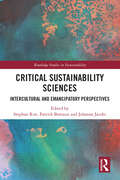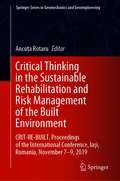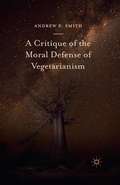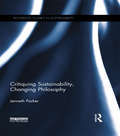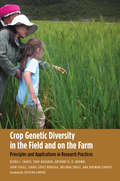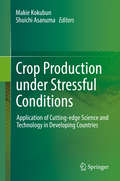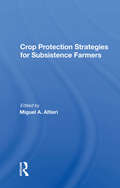- Table View
- List View
Critical Sustainability Sciences: Intercultural and Emancipatory Perspectives (Routledge Studies in Sustainability)
by Stephan Rist Patrick Bottazzi Johanna JacobiThis book explores Critical Sustainability Sciences, a new field of scientific inquiry into sustainability issues. It builds on a highly novel integration of elements from relational ontologies, critical theory, political ecology, and intercultural philosophy in support of emancipatory perspectives on sustainability and development. The book Critical Sustainability Sciences begins by uncovering the weaknesses of mainstream sustainability science and debates on sustainable development. The new field of Critical Sustainability Sciences has grown out of a deep engagement with relational ontologies, which helps to overcome the dualist ontology underlying mainstream notions of sustainability and development. Dualist ontologies reinforce problematic anthropocentric divisions, for example, between humans and nature, subjects and objects, mind and matter, body and soul, etc. Examples from indigenous peoples in Bolivia, India, and Ghana – as well as integrative movements in Chile, Brazil, and Europe – show that relational conceptions of life, rooted in ecosophy and cosmosophy, can provide an intercultural philosophical foundation for Critical Sustainability Sciences. The book concludes by describing three key topics for exploration in Critical Sustainability Sciences: societal reorganization in view of emancipatory, existential, and cognitive self-determination; living labor and commons; and the development of new comprehensive relational scientific paradigms. This book will be of great interest to students, scholars, and practitioners of emancipatory and intercultural approaches to sustainability and development.
A Critical Theory for the Anthropocene (Anthropocene – Humanities and Social Sciences)
by Nathanaël WallenhorstThis volume, which is rooted in biogeophysical studies, addresses conceptions of political action in the Anthropocene and the tension between a desire to accomplish the Promethean project of modernity and a post-Promethean approach. This work explores the idea of an anthropological mutation of political consolidation from a “post-Promethean togetherness”, to creating the capacity to act together. The political thinking of the human condition developed by Hannah Arendt is important here as a resource for thinking about humanity in terms of human adventure. This has three dimensions: hubris, the world and coexistence referring respectively to the logic of profit of the homo oeconomicus, the logic of responsibility of the homo collectivus and the logic of the hospitality of the homo religatus. The intellectual and political attitude outlined in this book is an extension of critical theory: the work also puts forward a critique of what poses a problem in our relationship to the world and suggests how to overcome it, the ultimate goal being social transformation. The author propose an uprising and an anthropological consolidation of politics based on the revitalization that is brought about by the sharing of a conviviality both between humans and with what is non-human. The identification of conviviality as an educational paradigm to survive the Anthropocene gives us the much needed reason for hope despite this heritage of the Anthropocene. In addition to Arendtian thinking, this critical theory for the Anthropocene draws on the political thinking of several contemporary authors including Maurice Bellet, Hartmut Rosa, Andreas Weber, Dominique Bourg, and Christian Arnsperger. This volume is of interest to researchers in the Anthropocene.
Critical Thinking in the Sustainable Rehabilitation and Risk Management of the Built Environment: CRIT-RE-BUILT. Proceedings of the International Conference, Iași, Romania, November 7-9, 2019 (Springer Series in Geomechanics and Geoengineering)
by Ancuța RotaruThis proceedings book presents contributions to the International Conference on Critical Thinking in the Sustainable Rehabilitation and Risk Management of the Built Environment – CRIT-RE-BUILT – held in Iași, Romania, November 7–9, 2019. It mirrors outcomes in fundamental and applied research covering a broad palette of competences like observations, analysis, interpretation, evaluation, problem-solving and decision making. The book sets up eight chapters related to rehabilitation and risk in the built environment. Each chapter starts with a broad state-of-the-art presentation comprising the latest ideas and methods in the field assessing and asserting synthesized levels of research, development and novelty through a critical thinking process. The authors of the eight presentations are partners in the E+ Programme for Strategic Partnerships Rehabilitation of the Built Environment in the Context of Smart City and Sustainable Development Concepts for Knowledge Transfer and Lifelong Learning (RE-BUILT).
Critical Urban Infrastructure Handbook
by Takeshi Koike Takehiko Ono Masanori HamadaRepresents the State of the Art in Urban Lifeline Engineering Urban lifelines are buried or aboveground network systems used for water, sewerage, gas, power, and telecommunications. Dedicated to preserving the functions of lifeline systems against natural disasters, the Critical Urban Infrastructure Handbook is a vital compilation of urban utility
The Critical Villager: Beyond Community Participation
by Eric DudleyWhen aid to the Third World actually works it is usually on such a small scale that it makes little impact on the world's problems. Can demands for generalizable actions be reconciled with location-specific solutions? The Critical Villager considers how community-based technical aid can be made more effective and sustainable. Calling for development workers, policy makers and researchers to put themselves in the place of the intended beneficiaries of aid, it suggests concrete principles for action and research. It argues that participatory research and 'transfer of technology' should not be regarded as rival models for development but rather as complementary components in a single process of effective aid.
The Critical Villager: Beyond Community Participation
by Eric DudleyWhen aid to the Third World actually works it is usually on such a small scale that it makes little impact on the world's problems. Can demands for generalizable actions be reconciled with location-specific solutions? The Critical Villager considers how community-based technical aid can be made more effective and sustainable. Calling for development workers, policy makers and researchers to put themselves in the place of the intended beneficiaries of aid, it suggests concrete principles for action and research. It argues that participatory research and 'transfer of technology' should not be regarded as rival models for development but rather as complementary components in a single process of effective aid.
Critically Engaging Participatory Action Research
by Sara KindonThis timely and informative book reasserts the value of Critical Participatory Action Research (CPAR): an approach to participatory action research (PAR) that is informed by critical theories attending to questions of privilege and power, and that generates collaborations focused on challenging structural inequality.The authors, writing explicitly from Minority World perspectives, are experienced researcher-practitioners who have worked with communities in the UK, USA, South Africa, Australia, India, and Colombia over many years. They offer an assessment, exploration, and illustration of CPAR at this point in time, outlining how the approach has evolved over time and space. Exploring its roots in strands of critical thought including postcolonialism, anti-imperialism, feminism, antiracism, queer theory, and Indigenous ontologies, the book asks how PAR is being critically re-engaged to maintain its commitment to greater justice and transformational change. Each chapter provides a rich case study of how these theories inform current collaborations and offers reflection on the entanglements of power that come with attempting CPAR in different institutional and geopolitical contexts. Their examples show that critical interrogation of PAR practices may lead to innovative and impactful outcomes for those involved, as well as new theoretical and substantive research findings.The collection will be of especial interest to students and researchers across the social sciences and humanities, as well as those working outside universities, who are interested in developing or extending their use of CPAR.
Critically Engaging Participatory Action Research
by Rachel Pain Mike Kesby Sara KindonThis timely and informative book reasserts the value of Critical Participatory Action Research (CPAR): an approach to participatory action research (PAR) that is informed by critical theories attending to questions of privilege and power, and that generates collaborations focused on challenging structural inequality.The authors, writing explicitly from Minority World perspectives, are experienced researcher-practitioners who have worked with communities in the UK, USA, South Africa, Australia, India, and Colombia over many years. They offer an assessment, exploration, and illustration of CPAR at this point in time, outlining how the approach has evolved over time and space. Exploring its roots in strands of critical thought including postcolonialism, anti-imperialism, feminism, antiracism, queer theory, and Indigenous ontologies, the book asks how PAR is being critically re-engaged to maintain its commitment to greater justice and transformational change. Each chapter provides a rich case study of how these theories inform current collaborations and offers reflection on the entanglements of power that come with attempting CPAR in different institutional and geopolitical contexts. Their examples show that critical interrogation of PAR practices may lead to innovative and impactful outcomes for those involved, as well as new theoretical and substantive research findings.The collection will be of especial interest to students and researchers across the social sciences and humanities, as well as those working outside universities, who are interested in developing or extending their use of CPAR.
A Critique of the Moral Defense of Vegetarianism
by Andrew F. SmithDrawing on research in plant science, systems ecology, environmental philosophy, and cultural anthropology, Andrew F. Smith shatters the distinction between vegetarianism and omnivorism. The book outlines the implications that these manufactured distinctions have for how we view food and ourselves as eaters.
Critiquing Sustainability, Changing Philosophy (Routledge Studies in Sustainability)
by Jenneth ParkerTo increasing numbers of people, sustainability is the key challenge of the twenty-first century. In the many fields where it is a goal, persistent problems obstruct the efforts of those trying to make a difference. The task of this book is to provide an overview of the current state of philosophy in the context of what philosophy is, could be or should be – in relation to sustainability and the human future on Earth. The book is conceived as a contribution to the UN Decade of Education for Sustainable Development, helping to link work on philosophy and sustainability. Critiquing Sustainability, Changing Philosophy focusses on the importance of philosophical work to the formation and effectiveness of global civil society and social movements for sustainability in the context of the Anthropocene age of the Earth. It takes a transdisciplinary systems approach that challenges philosophy and concludes by proposing a greatly enhanced role for philosophy in contributing to global public reason for sustainability. This book will be of interest to philosophers, sustainability practitioners and thinkers, policy makers and all those engaged in the global movement for sustainability.
Critiquing Sustainability, Changing Philosophy (Routledge Studies in Sustainability)
by Jenneth ParkerTo increasing numbers of people, sustainability is the key challenge of the twenty-first century. In the many fields where it is a goal, persistent problems obstruct the efforts of those trying to make a difference. The task of this book is to provide an overview of the current state of philosophy in the context of what philosophy is, could be or should be – in relation to sustainability and the human future on Earth. The book is conceived as a contribution to the UN Decade of Education for Sustainable Development, helping to link work on philosophy and sustainability. Critiquing Sustainability, Changing Philosophy focusses on the importance of philosophical work to the formation and effectiveness of global civil society and social movements for sustainability in the context of the Anthropocene age of the Earth. It takes a transdisciplinary systems approach that challenges philosophy and concludes by proposing a greatly enhanced role for philosophy in contributing to global public reason for sustainability. This book will be of interest to philosophers, sustainability practitioners and thinkers, policy makers and all those engaged in the global movement for sustainability.
Crop Adaptation to Climate Change
by Shyam Singh Yadav Robert J. Redden Jerry L. Hatfield Hermann Lotze-Campen Anthony J. HallA major task of our time is to ensure adequate food supplies for the world's current population (now nearing 7 billion) in a sustainable way while protecting the vital functions and biological diversity of the global environment. The task of providing for a growing population is likely to be even more difficult in view of actual and potential changes in climatic conditions due to global warming, and as the population continues to grow. Current projections suggest that the world's temperatures will rise 1.8-4.0 by 2100 and population may reach 8 billion by the year 2025 and some 9 billion by mid-century, after which it may stabilize. This book addresses these critical issues by presenting the science needed not only to understand climate change effects on crops but also to adapt current agricultural systems, particularly in regard to genetics, to the changing conditions. Crop Adaptation to Climate Change covers a spectrum of issues related to both crops and climatic conditions. The first two sections provide a foundation on the factors involved in climate stress, assessing current climate change by region and covering crop physiological responses to these changes. The third and final section contains chapters focused on specific crops and the current research to improve their genetic adaptation to climate change. Written by an international team of authors, Crop Adaptation to Climate Change is a timely look at the potentially serious consequences of climate change for our global food supply, and is an essential resource for academics, researchers and professionals in the fields of crop science, agronomy, plant physiology and molecular biology; crop consultants and breeders; as well as climate and food scientists.
Crop Genetic Diversity in the Field and on the Farm: Principles and Applications in Research Practices (Yale Agrarian Studies Series)
by Devra I. Jarvis Toby Hodgkin Anthony H. Brown John Tuxill Isabel López Noriega Melinda Smale Bhuwon SthapitBased on twenty years of global research, this is the first comprehensive reference on crop genetic diversity as it is maintained on farmland around the world. Showcasing the findings of seven experts representing the fields of ecology, crop breeding, genetics, anthropology, economics, and policy, this invaluable resource places farmer-managed crop biodiversity squarely in the center of the science needed to feed the world and restore health to our productive landscapes. It will prove to be an essential tool in the training of agricultural and environmental scientists seeking the solutions necessary to ensure healthy, resilient ecosystems for future generations.
Crop Genetic Resources as a Global Commons: Challenges in International Law and Governance (Issues in Agricultural Biodiversity)
by Michael Halewood Isabel López Noriega Selim LouafiFarmers have engaged in collective systems of conservation and innovation – improving crops and sharing their reproductive materials – since the earliest plant domestications. Relatively open flows of plant germplasm attended the early spread of agriculture; they continued in the wake of (and were driven by) imperialism, colonization, emigration, trade, development assistance and climate change. As crops have moved around the world, and agricultural innovation and production systems have expanded, so too has the scope and coverage of pools of shared plant genetic resources that support those systems. The range of actors involved in their conservation and use has also increased dramatically. This book addresses how the collective pooling and management of shared plant genetic resources for food and agriculture can be supported through laws regulating access to genetic resources and the sharing of benefits arising from their use. Since the most important recent development in the field has been the creation of the multilateral system of access and benefit-sharing under the International Treaty on Plant Genetic Resources for Food and Agriculture, many of the chapters in this book will focus on the architecture and functioning of that system. The book analyzes tensions that are threatening to undermine the potential of access and benefit-sharing laws to support the collective pooling of plant genetic resources, and identifies opportunities to address those tensions in ways that could increase the scope, utility and sustainability of the global crop commons.
Crop Genetic Resources as a Global Commons: Challenges in International Law and Governance (Issues in Agricultural Biodiversity)
by Michael Halewood Isabel López Noriega Selim LouafiFarmers have engaged in collective systems of conservation and innovation – improving crops and sharing their reproductive materials – since the earliest plant domestications. Relatively open flows of plant germplasm attended the early spread of agriculture; they continued in the wake of (and were driven by) imperialism, colonization, emigration, trade, development assistance and climate change. As crops have moved around the world, and agricultural innovation and production systems have expanded, so too has the scope and coverage of pools of shared plant genetic resources that support those systems. The range of actors involved in their conservation and use has also increased dramatically. This book addresses how the collective pooling and management of shared plant genetic resources for food and agriculture can be supported through laws regulating access to genetic resources and the sharing of benefits arising from their use. Since the most important recent development in the field has been the creation of the multilateral system of access and benefit-sharing under the International Treaty on Plant Genetic Resources for Food and Agriculture, many of the chapters in this book will focus on the architecture and functioning of that system. The book analyzes tensions that are threatening to undermine the potential of access and benefit-sharing laws to support the collective pooling of plant genetic resources, and identifies opportunities to address those tensions in ways that could increase the scope, utility and sustainability of the global crop commons.
Crop Pollination by Bees, Volume 1: Evolution, Ecology, Conservation, and Management
by Dr Keith DelaplaneSince the second half of the 20th Century, our agricultural bee pollinators have faced mounting threats from ecological disturbance and pan-global movement of pathogens and parasites. At the same time, the area of pollinator-dependent crops is increasing globally with no end in sight. Never before has so much been asked of our finite pool of bee pollinators. This book not only explores the evolutionary and ecologic bases of these dynamics, it translates this knowledge into practical research-based guidance for using bees to pollinate crops. It emphasizes conserving wild bee populations as well as culturing honey bees, bumble bees, and managed solitary bees. To cover such a range of biology, theory, and practice from the perspectives of both the pollinator and the crop, the book is divided into two volumes. Volume 1 focuses on bees, their biology, coevolution with plants, foraging ecology and management, and gives practical ways to increase bee abundance and pollinating performance on the farm. Volume 2 (also available from CABI) focuses on crops, with chapters addressing crop-specific requirements and bee pollination management recommendations. Both volumes will be essential reading for farmers, horticulturists and gardeners, researchers and professionals working in insect ecology and conservation, and students of entomology and crop protection.
Crop Pollination by Bees, Volume 2: Individual Crops and their Bees
by Dr Keith DelaplaneSince the second half of the 20th Century, our agricultural bee pollinators have faced mounting threats from ecological disturbance and pan-global movement of pathogens and parasites. At the same time, the area of pollinator-dependent crops is increasing globally with no end in sight. Never before has so much been asked of our finite pool of bee pollinators. This book not only explores the evolutionary and ecologic bases of these dynamics, it translates this knowledge into practical research-based guidance for using bees to pollinate crops. It emphasizes conserving wild bee populations as well as culturing honey bees, bumble bees, and managed solitary bees. To cover such a range of biology, theory, and practice from the perspectives of both the pollinator and the crop, the book is divided into two volumes. Volume 1 focuses on bees, their biology, coevolution with flowering plants, foraging ecology and management, and gives practical ways to increase bee abundance and pollinating performance on the farm. Volume 2 (this volume) focuses on crops, with chapters addressing crop-specific requirements and bee pollination management recommendations. Both volumes are essential reading for farmers, horticulturists and gardeners, researchers and professionals working in insect ecology and conservation, and students of entomology and crop protection.
Crop Post-Harvest: Principles and Practice
by Peter Golob Graham Farrell John E. OrchardWorld-wide losses of crops, post-harvest, through microbial action, pests, diseases and other types of spoilage amount to millions of tons every year. This essential handbook is the first in a three-volume series which covers all factors affecting post-harvest quality of all major fruits, vegetables, cereals and other crops. Compiled by members of the world-renowned Natural Resources Institute at the University of Greenwich, Chatham, UK, the comprehensive contents of this landmark publication encourage interactions between each sector of the agricultural community in order to improve food security, food safety and food quality in today’s global atmosphere. Through the carefully compiled and edited chapters, internationally respected authors discuss ways to improve harvest yield and quality, drawing on their many years’ practical experience and the latest research findings, applications and methodologies. Subjects covered include: an introduction to the systems used in post-harvest agricultural processes, physical and biological factors affecting post-harvest commodities, storage issues, pest management, food processing and preservation, food systems, the latest research and assimilation of this work, and current trade and international agreements. An invaluable glossary showing important pests, pathogens and plants is also included. Crop Post-Harvest: Science and Technology Volume 1: Principles and Practice is a must-have reference book which offers the reader an overview of the globalisation of post-harvest science, technology, economics, and the development of the storage and handling of perishable and durable products. Volumes 2 and 3 will go on to explore durables and perishables individually in more detail, with many case studies taken from around the globe. This 3-volume work is the standard handbook and reference for all professionals involved in the harvesting, shipping, storage and processing of crops, including agricultural and plant scientists, food scientists and technologists, microbiologists, plant pathologists, entomologists and all post harvest, shipping and storage consultants. Libraries in all universities and research establishments where these subjects are studied and taught should have multiple copies on their shelves.
Crop Post-Harvest: Durables - Case Studies in the Handling and Storage of Durable Commodities
by Rick Hodges Graham FarrellDurable commodities are the raw products from which food can be made and are the staples on which most humans rely; with but a few exceptions they are the seeds of plants. Volume 1 of this ground-breaking book series (details below) explains how crops should be dried, handled, protected from pests and stored by smaller holders or large-scale enterprises. This second volume presents a series of case studies on how durable crops are actually stored and marketed. The compilation of this three-volume work has been supported and is endorsed by the Natural Resources Institute of the University of Greenwich, U.K. The editors of this comprehensive and thorough book are well known and respected in the world of post-harvest science and technology. They have drawn together 36 expert contributors from Europe, North America, Asia, Australasia, South America and Africa to provide a huge wealth of information on major world crops including rice, maize, wheat, barley, sorghum, beans, cowpea, oilseeds, peanuts, copra, coffee, cocoa, dried fruit and nuts, and dried fish. Crop Post Harvest, Volume 2 is an essential purchase for cereal technologists, food scientists and technologists, agricultural scientists, entomologists, post-harvest crop protection specialists and consultants, commercial growers, shippers and warehousing operatives, and personnel of packaging companies. Researchers and upper-level students in food science, food technology, post-harvest science and technology, crop protection, applied biology, and plant and agricultural sciences will find a huge amount of great use within this landmark publication and the three-volume series as a whole. All libraries in research establishments and universities where these subjects are studied and taught should have several copies of each on their shelves.
Crop Post-Harvest: Perishables
by Debbie Rees Graham Farrell John OrchardInternational trade in high value perishables has grown enormously in the past few decades. In the developed world consumers now expect to be able to eat perishable produce from all parts of the world, and in most cases throughout the year. Perishable plant products are, however, susceptible to physical damage and often have a potential storage life of only a few days. Given their key importance in the world economy, Crop Post-Harvest Science and Technology: Perishables devotes itself to perishable produce, providing current and comprehensive knowledge on all the key factors affecting post-harvest quality of fruits and vegetables. This volume focuses explicitly on the effects and causes of deterioration, as well as the many techniques and practices implemented to maintain quality though correct handling and storage. As highlighted throughout, regular losses caused by post-harvest spoilage of perishable products can be as much as 50%. A complete understanding, as provided by this excellent volume, is therefore vital in helping to reduce these losses by a significant percentage. Compiled by members of the world-renowned Natural Resources Institute at the United Kingdom's University of Greenwich, with contributions from experts around the world, this volume is an essential reference for all those working in the area. Researchers and upper-level students in food science, food technology, post-harvest science and technology, crop protection, applied biology and plant and agricultural sciences will benefit from this landmark publication. Libraries in all research establishments and universities where these subjects are studied and taught should ensure that they have several copies for their shelves.
Crop Post-Harvest: Perishables
by Debbie Rees Graham Farrell John OrchardInternational trade in high value perishables has grown enormously in the past few decades. In the developed world consumers now expect to be able to eat perishable produce from all parts of the world, and in most cases throughout the year. Perishable plant products are, however, susceptible to physical damage and often have a potential storage life of only a few days. Given their key importance in the world economy, Crop Post-Harvest Science and Technology: Perishables devotes itself to perishable produce, providing current and comprehensive knowledge on all the key factors affecting post-harvest quality of fruits and vegetables. This volume focuses explicitly on the effects and causes of deterioration, as well as the many techniques and practices implemented to maintain quality though correct handling and storage. As highlighted throughout, regular losses caused by post-harvest spoilage of perishable products can be as much as 50%. A complete understanding, as provided by this excellent volume, is therefore vital in helping to reduce these losses by a significant percentage. Compiled by members of the world-renowned Natural Resources Institute at the United Kingdom's University of Greenwich, with contributions from experts around the world, this volume is an essential reference for all those working in the area. Researchers and upper-level students in food science, food technology, post-harvest science and technology, crop protection, applied biology and plant and agricultural sciences will benefit from this landmark publication. Libraries in all research establishments and universities where these subjects are studied and taught should ensure that they have several copies for their shelves.
Crop Production and Global Environmental Issues
by Khalid Rehman HakeemMeeting the world’s food security challenge will require a multi-national, collaborative effort to integrate the best research from science, engineering and socioeconomics so that technological advances can bring benefits where they are most needed. The present book covers the effect of major environmental problems on crop production and how to cope with these issues for sustainable agriculture and improvements of crops. The world’s population is predicted to hit 9.6 Billion by 2050, up from today’s total of nearly 7.3 Billion, and with it food demand is predicted to increase substantially. The post-war ‘second agricultural revolution’ in developed countries, and the ‘green revolution’ in developing nations in the mid- 1960s converted agricultural practices and elevated crop yields spectacularly, but the outcome is levelling off and will not meet projected demand. Simultaneously, crop production is affected by many other factors, including industrial pollution, overuse of fertilizers and insecticides, heavy metal and radiation stresses etc. It has been noted that many pests are becoming resistant to insecticides. Estimates vary, but around 25% of crops can be lost to pests and diseases. Climate change associated with agriculture is also a global issue. Agriculture is a significant contributor to greenhouse gases and is estimated to account for 10-12% of total greenhouse gas (GHG) emissions. Many of the issues highlighted are global problems and are addressed thoroughly in this work.
Crop Production under Stressful Conditions: Application of Cutting-edge Science and Technology in Developing Countries
by Shuichi Asanuma Makie KokubunThis book presents field studies on crop production in developing countries such as Vietnam, Kenya, Namibia, Colombia, Afghanistan and Sudan. Further, it examines the achievements of SATREPS, a development assistance program sponsored by the Japanese government that promotes international joint research to address these global issues. In this context, multidisciplinary research teams consisting of breeders, physiologists, soil scientists, agronomists, and other scientists related to agricultural development worked together to tackle the challenges involved in enhancing the capacity of crop production in the respective regions. In addition to presenting novel scientific findings, this book highlights practical field studies that verify the effectiveness of the scientific findings in actual environments. The achievements will help to improve crop production worldwide, and the lessons learnt will be useful in re-designing strategies to address global issues in crop production, particularly in developing regions. Lastly, the outcomes discussed will be useful to policymakers and professionals engaged in crop production and food security in developing countries, as well as researchers and students.
Crop Protection Strategies For Subsistence Farmers
by Miguel A AltieriTop-down approaches to pest management, relying on agrochemical inputs that can be scarce, expensive, ecologically toxic, or inaccessible, have repeatedly failed to solve pest problems that affect small farmers in developing countries. Crop Protection Strategies for Subsistence Farmers offers an alternative. Drawing on examples from Latin Am
Crop Protection Strategies For Subsistence Farmers
by Miguel A AltieriTop-down approaches to pest management, relying on agrochemical inputs that can be scarce, expensive, ecologically toxic, or inaccessible, have repeatedly failed to solve pest problems that affect small farmers in developing countries. Crop Protection Strategies for Subsistence Farmers offers an alternative. Drawing on examples from Latin Am
